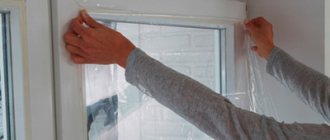Installing interior doors has several functions in an apartment or house. This is not only privacy in the room, but also the preservation of heat in the nursery, silence while relaxing in the bedroom, and the absence of odors from the kitchen while cooking. Installing wooden doors will require knowledge of the intricacies. But, if you follow the step-by-step instructions, installing the door yourself will not be difficult.
Diagram showing the dimensions of the required gaps on the doors
During installation there should be gaps between the door and the frame. Their sizes, formation, functionality need to be known in order to avoid serious mistakes.
When is clearance adjustment necessary?
During installation, the horizontal and vertical positions of the door frame can be determined by using a spirit level. Poor quality installation can be identified by the following signs:
- the door opens or closes by itself;
- the door frame is skewed;
- the door does not fit tightly to the frame;
- the door rubs against the frame.
If at first the violations may not be noticed, then over time the problems will only worsen. As a result, the door leaf may change its size, warp, sag, chips or scratches may appear, squeaking and other troubles may appear. In addition, humidity and temperature changes also accelerate the manifestation of unpleasant moments.
Requirements for clearances according to GOST
You can avoid future troubles during the installation process. To do this, it is worth taking into account the presence of all required gaps. There are certain requirements for them.
The gaps between the floor and the door leaf depend on the type of coating. Most often, the sizes range from 8-15 mm, but sometimes they can be increased to 30 mm.
What gap between the door and the frame is acceptable according to GOST?
- Depending on the quality of the material and design features, the gap between the door and the door frame will be within 3.5-4.5 mm. Deviation from this value will affect the operation of the door handle.
- The size of the gap between the hinge post and the door ranges from 1.5-2.5 mm. There is no point in exceeding this distance.
- The distance from the ceiling strip to the door leaf should be no more than 3 mm.
- The gap between the door frame and the wall, according to the requirements, is 1-1.5 cm. This distance is enough to allow you to adjust the components of the frame and fill the gap with polyurethane foam.
These requirements are still relevant today. And it is not recommended to change them.
Conclusion
Methods for insulating and closing gaps between the frame and the door leaf depend on the size of the gap, financial capabilities and type of door material. You can implement any insulation with your own hands, without much physical effort.
Rating: 5
Voted over 266 times, average rating 4.2
Comments
Ksenia 09/10/201711:10
I wonder if self-adhesive tape will fit well on a wooden slope? Won't it fall off in a week?
Rating: 5
Grade
Add a comment Cancel reply
We recommend reading
Miscellaneous Installation of a threshold for the front door in a private house: we select and do it ourselves The threshold under the front door prevents entry into the house...
Miscellaneous What to do if condensation appears on the front door? During the off-season or winter, owners of private houses face...
Miscellaneous How and with what to lubricate a metal entrance door if it creaks? A door that squeaks is a nuisance, especially if it...
Miscellaneous Varieties and manual installation of seals for interior doors No matter how good and expensive an interior door is, its ...
Clearances for metal doors
Often, when buying a steel door, they do not pay attention to the gaps between the door leaf and the frame. Of course, there are more important factors, but this nuance is also important. To avoid subsequent troubles, you should pay attention to several technical details:
- The steel structure will expand at high air temperatures. Therefore, if the gap between the door and the frame was less than 1 mm, the leaf will jam and the door simply will not open.
- The same thing can happen if the door suddenly sag. The difficulty of adjustment depends on the type of hinges.
- Too large a gap between the frame and the metal door is also not an option. Even if there is a large seal, this is not enough to block access to the smell of smoke, noise, and drafts.
- In addition, the long distance makes it easier for burglars to work.
To avoid the above troubles, you should take into account the gaps. Their values are as follows: for small single-leaf structures - 3 mm, for larger systems - 4 mm, for heavy and double-leaf doors - 5 mm and more.
Photos of completed work
Door warranty
The warranty on metal doors is 5 years, during which, if necessary, we will carry out service repairs of the door structure or replacement of components.
Our service department is always happy to help you even after the warranty period has expired.
Gaps for interior doors
The gaps between the door and the interior door frame depend on several factors. Namely, on the weight of the door, its width and height. When installing the door, the gap should be 6 mm, with a permissible error of 1 mm.
With standard door leaf dimensions (200 x 60 x 90), the gaps should be no more than 5 mm. But if the room is in conditions of high humidity, then the distance should be 2 mm larger. And all because the wooden door swells from absorbed moisture.
Standard door kit
If there is a standard door set with dimensions of 200x60x90 cm, then the gap should be 3-4mm on all sides. It is allowed to form a lumen of up to 5 mm if:
- the room has high humidity and ventilation is needed;
- the doors are made of a material that absorbs moisture very well.
It is worth paying attention to the distance from the threshold to the canvas. Under normal conditions, it is 2–2.5 cm. If you need to ensure improved ventilation and unhindered opening, the distance can be increased to 4 cm.
Door seal
How are gaps formed?
To avoid the formation of very large gaps or, conversely, the development of small gaps, you need to install the door correctly. To do this, just follow a few rules:
- During the installation of the door frame, 10-20 mm are left for the primary gaps. This is because the polyurethane foam swells and begins to put pressure on the box.
- After the foam has completely dried and hardened, you can begin to form the gaps between the door and the door frame. To do this, a material with a thickness that will correspond to the future gap is placed on both sides of the canvas and on top. With a standard structure size, this value is 3-4 mm. The best option is packaging cardboard from a door kit.
- To prevent the box from moving in the opening, it must be wedged.
- Using a building level, check the balancing of the door leaf. It should sit firmly on the “wedges”, and the entire door structure should not wobble.
Tools
To install interior doors, as well as create precise gaps, you will need the following tools:
- Pencil, meter, corner.
- Plumb lines, level.
- Wooden spacers with a width equal to the width of the door leaf.
- Polyurethane foam, construction gun.
- Construction knife.
- Hammer.
- Screwdriver or screwdriver.
- Chisel.
- Electric drill.
During the work you may need a hammer. You should also prepare wedges and spacers made of wood. To install the doors, these tools will be enough, you can begin installing the interior doors.
Incorrect clearance. What to do?
Situations when the gap between the door and the frame is too small or, conversely, very large, are not uncommon. In the first case, the door leaf is reduced, and in the second, the gap is reduced.
First of all, check whether the box is skewed. To do this, use a building level. It is important that the angles (all 90°) and diagonals are respected (the distances between opposite corners are the same).
When the gap is small, carry out the following steps:
- the door is removed from its hinges and cleaned of old paint (especially important if the paint is very old, since its layering greatly reduces the distance);
- if the door is not painted, then use a plane or chisel to remove a few millimeters of wood until the desired gap is formed.
If the gap between the door and the frame is too large (for a standard design - over 6 mm), then the gap is insulated and closed.
Tips and tricks
Sometimes situations arise when the door does not close or the door leaf rubs against the frame beam. To fix this problem, you need to dismantle the sash by removing it from its hinges. If it has been painted, then it is necessary to remove the coating. Place it on one end side and remove the layer of wood with a plane. At the junction points this must be done carefully.
This operation is carried out only when the deformation did not occur as a result of swelling from moisture. To do this, you need to lay it horizontally, leaving it to dry for a couple of days.
It happens that doors simply shrink with age, increasing the gaps. In this case, the lock stops closing, and the tongue does not reach the keyhole.
In this case, the following types of work must be done:
- Remove the door. The canvas must be moved to the distance of the gap formed. Use a chisel to make a place for the hinge and drill new holes for the screws.
- On the side where the hinges are hung, an overhead thin strip is stuffed. We take the thickness of the strip based on the displacement of the door leaf.
- To reduce the distance from the interior door to the floor, you need to secure a seal.
By providing the structure with the necessary clearances, you can be sure of proper functioning and a long service life.
New doors are installed for the following reasons:
- simple delimitation of space for the purpose of privacy;
- keeping warm in the children's room;
- for silence in the bedroom;
- as a decoration in a designer interior.
To install the entire structure correctly and efficiently, certain knowledge is required. Observing some subtleties, installation will not cause any problems. When carrying out installation work, you need to monitor the door gap between the door leaf and the frame.
Self-installation is a lengthy process and requires the necessary skills. The main requirement remains compliance with the gaps when installing an interior door.
When performing installation for the first time, it is very easy to make a mistake. After reading this short guide, you will find answers to many questions that will help people without experience to correctly perform this kind of work.
Source: vseodveri.ru
Materials for insulating cracks
Many different materials are used to insulate the gap. But before you start insulating, you need to decide how much smaller the gap should be.
When choosing a material for insulation, it is important to pay attention not only to aesthetics, but also to take into account the insulating qualities. After all, this determines the reduction of sound transmission, drafts and, in addition, eliminates door slamming.
The most popular materials for insulation are silicone paste and sealing tape. But they also use stuffing strips of felt (or any other dense fabric) or thin slats in places where there are cracks. The choice of material depends on the location of the door installed and the size of the gap.
Insulation with silicone mass
Construction silicone is sold in small tubes. It can be either white or transparent in color. To apply the paste, use a special gun. You can find it at any hardware store.
To insulate the gap with silicone, perform the following steps:
- To avoid contamination of the door leaf, areas where no work will be carried out are coated with Vaseline.
- The tube is inserted into the gun.
- The tip must be cut so that the thickness of the strip of silicone paste is slightly greater than the existing gap.
- The gun is held to the jamb at an angle of 45°.
- You need to press the gun lever softly and smoothly. This will help avoid excess paste.
- When all surfaces have been treated, close the door and allow the silicone to dry completely. The drying time is indicated on the tube with silicone mass.
- When the time is up, the door must be opened and the excess silicone paste removed.
This material is extremely convenient, as silicone takes the desired shape.
Insulation with sealing tape
Such tapes can be made of either plastic or rubber. Their cost is not high, and they are easy to use. But it’s easiest to work with self-adhesive ones. That is, on one side, such a tape has a thin layer of glue that adheres tightly if the surface is pre-prepared.
The sizes of the sealing tape may vary. And it’s not difficult to choose what you need. The main disadvantage of this material is that it needs to be replaced over time. Especially if the door is constantly closed. In this case, the tape becomes thinner (compressed), which impairs its performance.
Installation of the sealing film is as follows:
- the surface is cleaned of dust and degreased;
- measure the length of the tape and cut it with a margin of up to 10 mm;
- separate the protective film by 5-10 cm;
- It is best to start gluing from the top corner, applying the tape to the door frame;
- if necessary, peel off the protective film;
- The tape itself is pressed tightly against the surface during installation;
- in places where hinges are fixed, the film is glued to the front surface of the stopper or to the inner surface of the door;
- In the corners, the joints of the tape are carefully trimmed.
In addition, the sealing strip may not be self-adhesive. This option is cheaper and has a different installation method:
- the surface is cleaned of dust;
- measure and cut the required length of the tape;
- With the door closed, apply the tape tightly;
- secure the sealing strip using short nails.
Thus, carry out installation along the entire perimeter of the box. The distance between nails should be no more than 10 cm.











